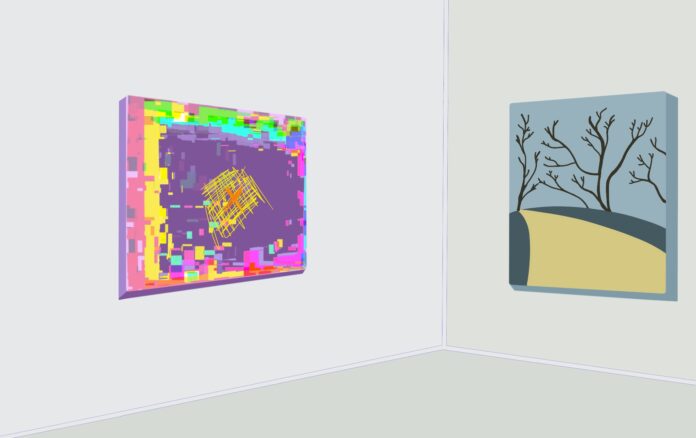On Mar. 27, the university’s department of Fine Arts opened Flux 2021, the 47th annual senior thesis exhibition.
The show features work by 20 fourth-year students from the department, whose pieces explore a wide range of themes including experiences in the diasporic community, family, gender, mortality, memory and connection. The students have employed many mediums, such as traditional painting, textiles, digital art, drawing and installation to communicate their ideas.
Unlike the department’s previous shows, Flux is a virtual experience. The live-streamed opening on Youtube began with acknowledgements from the Director of Special Programs Monica Leoni, and members of the Fine Arts faculty, Tara Cooper and Lois Andison. Throughout the show, each artist shared their work and a part of their process or inspiration, from Shannon Stehr whose crocheted pieces were inspired by her grandmother to Kate Short’s plant artworks that are connected to self-health.
The event also included the Curator’s Choice Award, which was awarded to both Diana Tran, who reconstructed her father’s memories in the form of a diorama, and Lupita Guerrero, who used translation as a way to describe generational gaps of understanding.
The graduating class selected the name “Flux” to represent the challenges of their final year in the program and the impact the COVID-19 pandemic has had on their lives. “Flux means many things: a state of flow, an in-between space, a state of change, all while leaving room to ebb and flow,” said Baz Kanold, one of the participating artists. “Our graduating class has experienced quite a state of flux in our final year, along with our fellow students at UW and the rest of the world. In the midst of this global crisis, we are drawing on our arts communities and artistic practices to reflect on the past and to unpack and seek change in our present.”
Kanold noted that students have had to adapt their methods of work as they long for moments spent in their East Campus Hall Studio. “The connections we have made are different than those past arts students have from struggling and succeeding together in person,” they said.
The name “Flux” was also inspired by Fluxus: an international art movement of the 1960s and 1970s that emphasized the creative process and created space for chance, happy accidents, creative play and the use of nearby materials during artistic creation. Notably, Fluxus was centred on the democratization of art and the importance of making art accessible.
Themes of connection, social commentary and social revolution are present throughout the Flux 2021 exhibition. “You can’t deny the new perspectives and avenues for change that artists have developed over the last 12 months. This change in how we view art in academia, and as a tool for change is a central focus in our show,” Kanold said.
Kanold’s artwork investigates and celebrates queerness, sexuality, and the fluidity of gender identity using mixed mediums. Dysphoria, their current project, is focused on the concept of gender dysphoria, and the difficulties of having your mind and body being in opposition to one another. On the Flux website they wrote, “to me, gender dysphoria is a form of aberration, a deviance, a glitch. The body and the mind war with each other using the body as a battleground. Gender dysphoria is, in itself, a contrast of connection and disassociation from parts of the body.” Over the pandemic, they have explored digital art more consistently, which they employed to represent their experiences with gender dysphoria as a non-binary person. “Working in digital, I capture the concept of aberration and glitching in its truest form.”
As a whole, experiencing Flux was powerful. It is remarkable how each artist presents their work in a way that beautifully and insightfully explores themes such as family, identity, emotions, and language. In a time when people are struggling with isolation and the social issues permeating our society, the UW Fine Arts students captured the spirit of their program’s work that will hopefully continue to inspire others for years to come. The senior students hope their graduating show’s audience will be broad and far-reaching. The artists’ works, statements and interviews are available on the show’s website.































